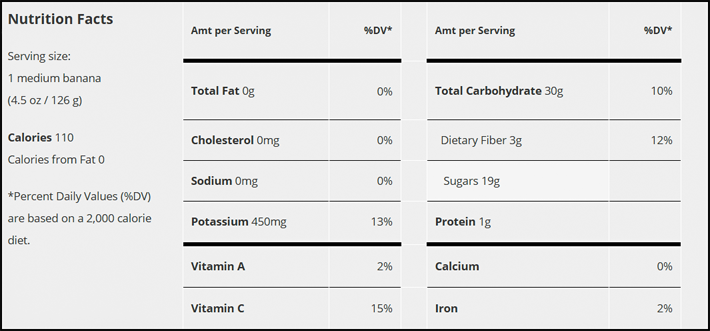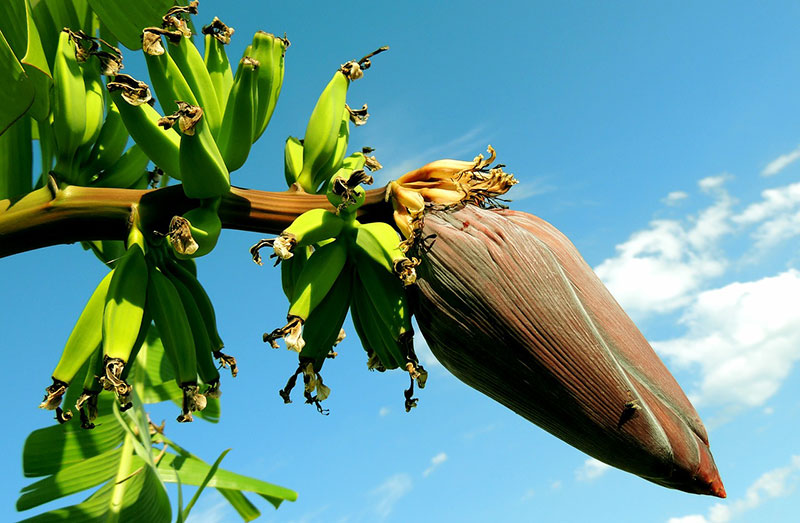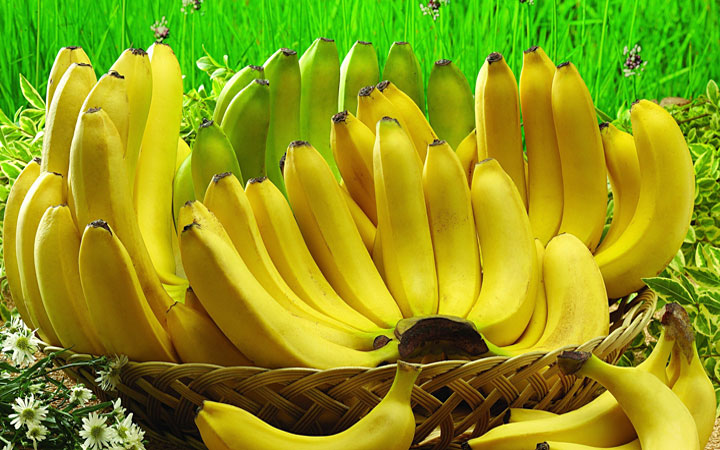
Bananas are among the most widely consumed fruits on the planet
According to the U.S. Department of Agriculture, bananas are Americans’ favorite fresh fruit. The curvy yellow fruits are high in “potassium and pectin, a form of fiber,” said Laura Flores, a San Diego-based nutritionist. They can also be a good way to get magnesium and vitamins C and B6. “Bananas are high in antioxidants, which can provide protection from free radicals, which we come into contact with every day, from the sunlight to the lotion you put on your skin,”
Flores reported a wide variety of health benefits associated with the fruit. “Bananas are known to reduce swelling, protect against developing type-2 diabetes, aid in weight loss, strengthen the nervous system and help with production of white blood cells, all due to the high level of vitamin B6 that they contain,”
Here are the nutrition facts for bananas, according to the U.S. Food and Drug Administration, which regulates food labeling through the National Labeling and Education Act:

Bananas Health benefits
Heart health
They are good for your heart. They are packed with potassium, a mineral electrolyte that keeps electricity flowing throughout your body, which is required to keep your heart beating. Bananas’ high potassium and low sodium content may also help protect your cardiovascular system against high blood pressure, according to the FDA.
Depression and mood
Bananas can be helpful in overcoming depression “due to high levels of tryptophan, which the body converts to serotonin, the mood-elevating brain neurotransmitter,” Flores said. Plus, vitamin B6 can help you sleep well, and magnesium helps to relax muscles.
Digestion and weight loss
Bananas are high in fiber, which can help keep you regular. One banana can provide nearly 10 percent of your daily fiber requirement. Vitamin B6 can also help protect against type 2 diabetes and aid in weight loss, according to Flores. In general, they are a great weight loss food because they taste sweet and are filling, which helps curb cravings. They also help sustain blood sugar levels during workouts.
Vision
Carrots may get all the glory for helping your eyes, but bananas do their share as well. The fruits contain a small but significant amount of vitamin A, which is essential for protecting your eyes, maintaining normal vision and improving vision at night, according to the National Institutes of Health. Vitamin A contains compounds that preserve the membranes around your eyes and are an element in the proteins that bring light to your corneas. Like other fruits, bananas can help prevent macular degeneration, an incurable condition, which blurs central vision.

Banana Tree
Bones
Bananas may not be overflowing with calcium, but they are still helpful in keeping bones strong. According to a 2009 article in the Journal of Physiology and Biochemistry, bananas contain an abundance of fructooligosaccharides. These are nondigestive carbohydrates that encourage digestive-friendly priobotics and enhance the body’s ability to absorb calcium.
Cancer
Some evidence suggests that moderate consumption of bananas may be protective against kidney cancer. A 2005 Swedish study found that women who ate more than 75 servings of fruits and vegetables cut their risk of kidney cancer by 40 percent, and that bananas were especially effective. Women eating four to six bananas a week halved their risk of developing kidney cancer.
Bananas may be helpful in preventing kidney cancer because of their high levels of antioxidant phenolic compounds.
Health risks
Eaten in moderation, there are no significant side effects associated with eating bananas. However, eating the fruits in excess may trigger headaches and sleepiness, Flores said. She said that such headaches are caused by “the amino acids in bananas that dilate blood vessels.” Overripe bananas contain more of these amino acids than other bananas. “Bananas can also contribute to sleepiness when eaten in excess due to the high amount of tryptophan found in them,” she said. Magnesium also relaxes the muscles — another sometimes-benefit, sometimes-risk.
They are a sugary fruit, so eating too many and not maintaining proper dental hygiene practices can lead to tooth decay. They also do not contain enough fat or protein to be a healthy meal on their own, or an effective post-workout snack.
Eating bananas becomes significantly risky only if you eat too many. The USDA recommends that adults eat about two cups of fruit a day, or about two bananas. If you eat dozens of them every day, there may be a risk of excessively high vitamin and mineral levels.
The University of Maryland Medical Center reported that potassium over consumption can lead to hyperkalemia, which is characterized by muscle weakness, temporary paralysis and an irregular heartbeat. It can have serious consequences, but you would have to eat about 43 bananas in a short time for any symptoms of hyperkalemia to occur.
According to the NIH, consuming more than 500 milligrams of vitamin B6 daily can possibly lead to nerve damage in the arms and legs. You would have to eat thousands of bananas to reach that level of vitamin B6.
Banana peels: edible or poisonous?
It turns out that the biggest risk from a banana peel might really be slipping on it. Banana peels are not poisonous. In fact, they’re edible, and packed with nutrients. “Banana peel is eaten in many parts of the world, though [it’s] not very common in the west,” Flores said. “It contains high amounts of vitamin B6 and B12, as well as magnesium and potassium. It also contains some fiber and protein.” According to a 2011 article in the journal of Applied Biochemistry and Biotechnology, banana peels also have “various bioactive compounds like polyphenols, carotenoids and others.”

It is important to carefully wash a banana peel before eating it due to the pesticides that may be sprayed in banana groves.
Banana peels are usually served cooked, boiled or fried in some capacity, though they can be eaten raw or put in a blender with other fruits. They are not as sweet as banana flesh. Riper peels will be sweeter than unripe ones.
Banana facts
- Bananas may have been the world’s first cultivated fruit. Archaeologists have found evidence of banana cultivation in New Guinea as far back as 8000 B.C.
- Bananas are produced mainly in tropical and subtropical areas of Africa, Asia and the Americas, as well as the Canary Islands and Australia.
- Bananas do not grow on trees. The banana plant is classified as an arborescent (tree-like) perennial herb, and the banana itself is considered a berry.
- The correct name for a bunch of bananas is a hand; a single banana is a finger.
- Nearly all the bananas sold in stores are cloned from just one variety, the Cavendish banana plant, originally native to Southeast Asia.
- The Cavendish replaced the Gros Michel after that variety was wiped out by fungus. The Gros Michel reportedly was bigger, had a longer shelf life and tasted better.
- The Cavendish may face the same fate as the Gros Michel within the next 20 years, botanists say.
- Bananas are also called plantains. But in general use, “banana” refers to the sweeter form of the fruit, which is often eaten uncooked, while “plantain” refers to a starchier fruit that is often cooked before eating.
- There are 50 recognized species of banana.
- Wild bananas grow throughout Southeast Asia, but most are inedible for humans, as they are studded with hard seeds.
- The vast majority of bananas grown today are for consumption by the farmers or the local community. Only 15 percent of the global production of the fruit is grown for export.
- India is the leading producer of bananas worldwide, accounting for 23 percent of the total banana production, though most of the Indian plantains are for domestic use.
- Harry Belafonte’s version of the “Banana Boat Song” was released on the first album to sell over a million copies, Belafonte’s “Calypso.”
Please follow us on Facebook Page and enjoy our collection of recipes, crafts, fitness, health tips, gardening, DIY and more…





Leave a Reply